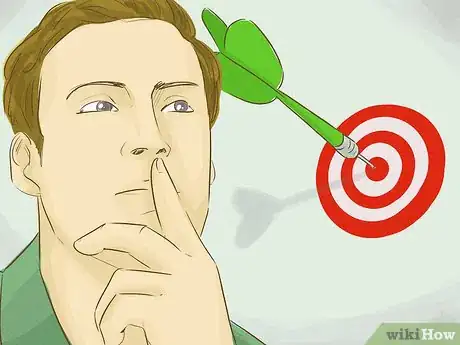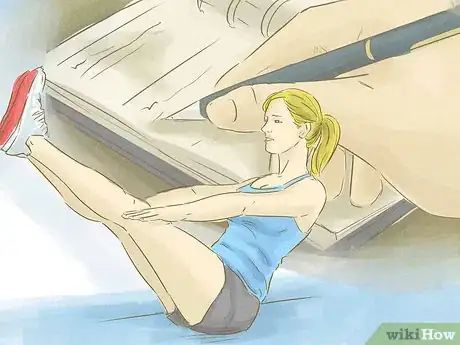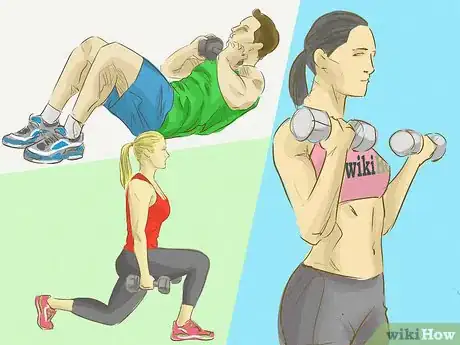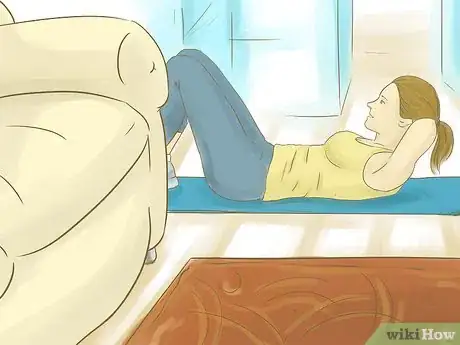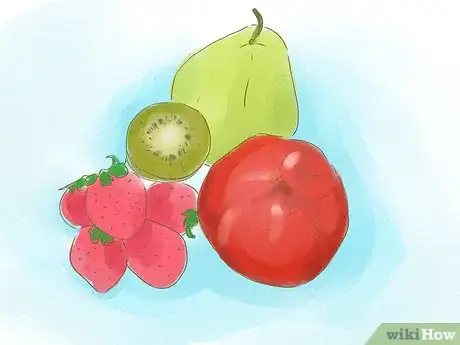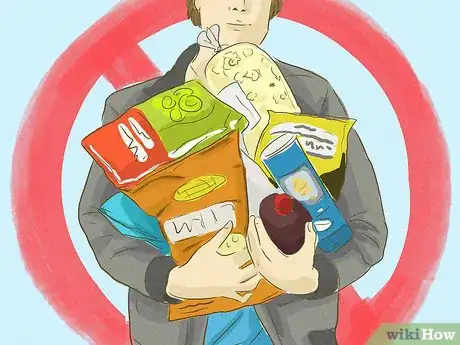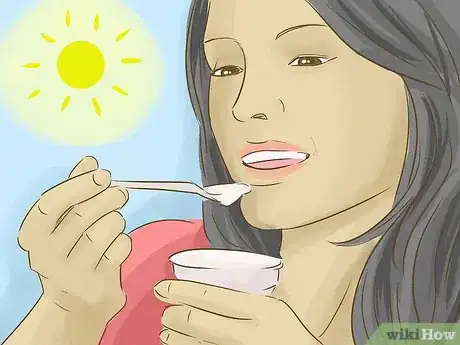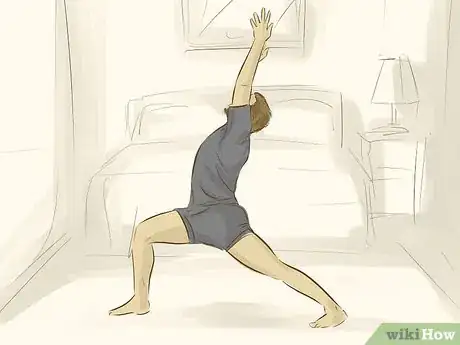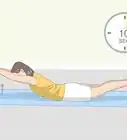This article was medically reviewed by Luba Lee, FNP-BC, MS. Luba Lee, FNP-BC is a Board-Certified Family Nurse Practitioner (FNP) and educator in Tennessee with over a decade of clinical experience. Luba has certifications in Pediatric Advanced Life Support (PALS), Emergency Medicine, Advanced Cardiac Life Support (ACLS), Team Building, and Critical Care Nursing. She received her Master of Science in Nursing (MSN) from the University of Tennessee in 2006.
There are 30 references cited in this article, which can be found at the bottom of the page.
This article has been viewed 83,267 times.
It can be hard to commit to a healthy lifestyle. Staying in old, comfortable routines often seems easier than making changes. By adopting an active lifestyle, eating a healthy diet, and making time for activities that promote happiness, you can get your life on a better track in just 2 weeks. Though health is a lifelong endeavor, starting slow and committing to 2 weeks of a healthy you is a great way to see that a different lifestyle is possible, and full of benefits to both body and mind.
Steps
Physical Activity
-
1Set clear goals for yourself to get in the right mindset. When you’re setting out to get fit, it can be hard to know where to start! Before you get to work, spend some time thinking about why you’re doing it and what you want to accomplish. From there, set some specific, realistic goals for yourself. This will make it easier for you to stick to your plan to get healthy.[1]
- Set goals that are SMART (specific, measurable, attainable, relevant, and time-bound). If your goals are too vague or overambitious, you’ll quickly get frustrated!
- It can be helpful to break your larger goals up into smaller ones. For instance, maybe your overall goal is to lose 10 pounds (4.5 kg) over the next month. Try setting smaller goals, like “I will walk for at least 30 minutes a day for the next 2 weeks,” and “I’m only going to eat home-cooked meals made from fresh ingredients during that time.”
- Tell a friend or family member about your goals—they can help you stay on track!
-
2Go by foot instead of by car when you can. This can be tricky depending on where you live, but spending less time in the car and more time on foot will help you lose weight, decrease stress, and elevate your mood. If you have the option, walk or bike to work or the grocery store instead of driving.[2] Otherwise, carve out 30 minutes a day to go for a walk.
- Call up a friend to go walking with you. This will give you a dose of healthy exercise and social activity at the same time!
Advertisement -
3Make a workout schedule to keep yourself on track. Figure out how much time you have each day to work out. Be realistic in your expectations and make a plan you can stick to.
- The recommended amount of exercise for healthy adults is 2 1/2 hours (150 minutes) each week of moderate aerobic activity and strength training 2 or more times weekly. This can be broken up to fit your lifestyle.[3]
- If you can, commit to doing cardio 30 minutes a day, 5 days a week, which meets the recommend 150 minutes. Or maybe a 1-hour cardio class (like Zumba dancing) 3 times a week works better for your schedule. Or maybe you need to break it up even more, with 20 minutes in the morning before work and another 20-minute walk on your lunch break.
- On days when you’re really busy, even a 7-minute workout routine can make a difference!
- Writing yourself a realistic workout schedule will help you plan workouts that can be accomplished within your timeframe and make you more likely to accomplish your goals.[4]
-
4Incorporate strength training into your routine. Building strength creates lean muscle mass and makes you look and feel healthy and toned. The best way to strength train efficiently is through compound movements (movements that work more than one muscle group) such as squats, deadlifts, and bench presses.[5] Aim to do strength training at least 2 times a week, and make sure to focus on all the major muscle groups.[6]
- Talk to a trainer or knowledgeable friend to learn how to safely do compound movements with weight.
- You can also use handheld weights to focus in on specific areas of the arms. When using handheld weights or doing bodyweight exercises, aim for 3 sets of 10-15 repetitions.
-
5Start doing high-intensity interval training (HIIT) to get fit fast. When it comes to losing weight and getting in shape, doing cardio activities for short bursts of time at very high intensity is the best bet. While running a few miles a day or going for a long walk are great activities to support a healthy lifestyle, HIIT is one of the best ways to quickly build strength and endurance.[7]
- Keep in mind that HIIT is not appropriate for everyone. Talk to your doctor before trying this workout.
- Pick a cardio activity that you enjoy. Walking, running, swimming, and elliptical are all good options.
- Start with a warmup of about 5 minutes. Then choose a shorter interval length, such as 30 seconds. Then do 30 seconds of high intensity effort of your chosen activity, followed by a longer period of recovery, such as 1 to 3 minutes. Repeat the exercise 10 times. For example, if you're a runner, try all-out sprinting for 30 seconds straight, resting for a minute, and repeating 10 times. Increase the time interval as you get in better shape.
- Only do this 2 to 3 times a week to avoid injury or burnout. Supplement HIIT with a few longer, slower-paced cardio workouts for distance throughout the week.[8]
-
6Work out at home if you can’t get to the gym. Working out at home is cheap, time efficient, and effective.[9] Pick up a few pieces of equipment such as push-up bars, hand-held weights, fit balls, exercise bands, or kettle bells. Make sure to work each major muscle group through cardio, strength training, and body weight exercises.
- When planning an at-home workout, give yourself enough time to complete a warmup, cardio, or strength routine, and a cooldown.
- Aim for doing 30 minutes of cardio 3 times a week and 20 to 30 minutes of strength training 3 times a week, followed by stretching.
- Some types of exercise you can do at home without weights or equipment include Barre, yoga, and HIIT (high intensity interval training).
-
7Find a workout buddy to help keep you motivated. Working out with someone else not only keeps you on track, but makes fitness more fun! Find someone with a similar schedule and goals to yours who will keep you motivated.[10]
Diet
-
1Eat more vegetables and fruits. Eating a diet rich in low glycemic index vegetables and fruits is essential to weight loss. It also provides your body with essential nutrients, such as vitamins, minerals, and fiber. Eat at least 5 servings of fruit and vegetables a day, and try to vary up the color as much as you can. Add some fruit and veggies to every meal to get your servings in.[11] Stick to vegetables and fruits that are low in sugar or have a low glycemic index, such as the foods listed here: https://www.nhrmc.org/~/media/testupload/files/low-gylcemic-meal-planning.pdf?la=en.
- Breakfast: add spinach, tomatoes, or mushrooms to your morning eggs in place of cheese. If you eat cereal or oatmeal, add fresh fruit such as a banana, blueberries, or strawberries. Make your oatmeal more filling by adding healthy sources of fat, such as nuts, flax seeds, or coconut oil.
- Lunch: Try making a big, filling salad with leafy greens, a lean protein (such as chicken, fish, or lean beef), nuts, dried fruit, and some carrots, peppers, onions, or broccoli. Or, add some greens, tomato, onion, or cucumber to a sandwich or wrap.
- Dinner: Instead of canned tomato sauce, sauté up broccoli, garlic, tomatoes, and peppers in olive oil and eat them with brown rice or sweet potatoes.[12] To help fill you up, add a healthy protein, such as wild-caught fish, chicken, or lean beef.
-
2Get rid of unhealthy foods in your fridge and pantry. It’s easier to make a change if you don’t have a bunch of junk food around, tempting you to make less healthy choices! If you're really going to start taking your health seriously, it's best to start from scratch. Get rid of all unhealthy foods and staples that you have in your fridge and pantry, and stock up on healthy alternatives instead. This will eliminate any temptation to go back to your old ways. Donate what you can to a local food bank. [13]
-
3Avoid highly processed fats and refined sugars. Highly processed foods loaded with fat and refined sugar are linked to diseases such as diabetes, cancer, heart disease, and stroke.[14] They fill you up without actually providing many of the nutrients you need. Fill your pantry with natural foods like whole grains (oats, quinoa, barley, buckwheat, whole grain breads and pastas), fruits and vegetables, legumes, nuts, meat, and protein or probiotic-rich dairy products (kefir, Greek yogurt, cottage cheese).
- Get all-natural sweeteners. For those with a sweet tooth, use honey, agave, or stevia instead of sugar in your coffee, tea, and baked goods.
-
4Stop mindlessly snacking. Eating when you're not hungry is one of the easiest ways to gain unwanted weight. Before you grab a snack, stop and ask yourself how you’re really feeling—are you actually hungry, or just bored or restless?[15] Only snack when you're hungry, and when you do, try to eat snacks high in protein, as this will keep you feeling full longer.
- A piece of whole grain toast with nut butter, a mozzarella cheese stick, a hardboiled egg, or hummus with veggies are great options for beating the mid-afternoon crash.[16]
-
5Try intermittent fasting to lose weight quickly. Intermittent fasting works with your body’s natural rhythms to help you burn fat and build muscle more efficiently. Try a simple intermittent fast by sticking to eating during the morning and early afternoon—for example, between 7 AM and 3 PM. Don’t eat anything in the late afternoon or evening.[17]
- Avoid the temptation to snack between your meals, and definitely don’t snack at night. Your body will be busy burning fat during those times!
- When you do eat, try to stick to nutritious foods like fresh vegetables and fruits, beans and peas, whole grains, lean proteins (like chicken and fish), and healthy fats (like avocados, vegetable oils, and nuts).
-
6Talk to your doctor about vitamins and other dietary supplements. Some supplements can boost your energy and improve your overall wellbeing—especially if you have any vitamin deficiencies. Talk to your doctor about whether a multivitamin or specific vitamin supplements might improve your health. Tell them about any health conditions you have and give them a full list of any supplements or medicines you’re already taking, since this can affect what you can take safely.[18]
- It’s generally best to get vitamins and minerals from your diet, but supplements can be helpful if you have a deficiency or a health condition that make it hard for you to get all the nutrients you need from food.
- Some supplements that might be helpful to your health include vitamins C, D, and E, zinc, chromium, and glutathione.
Stress Reduction
-
1Get at least 7-9 hours of sleep each night. Getting 7 to 9 hours of sleep a night is extremely important to maintaining a healthy lifestyle. Getting a good night's sleep improves your ability to learn, make good decisions, and cope with change. Lack of sleep is also linked to depression, heart disease, and obesity.[19]
- Everybody requires a different amount of sleep. Some will feel good and rested after 6 hours, others after 10. Experiment with sleeping a different amount of hours per night and see which quantity makes you feel best.[20]
- Create a good bedtime ritual. Relax with a book for 30 minutes before bed, or stretch and drink herbal tea. It's also important to stick to a sleep schedule, even on the weekends, so that your body can stay consistent.[21]
- If you still have trouble sleeping, some supplements may help. For instance, getting more magnesium may improve your sleep at night.[22] Try a 200-400mg magnesium supplement. Melatonin, which is a natural sleep hormone, can also improve your sleep quality by regulating your sleep/wake cycle.[23]
-
2Practice yoga to build strength and relieve stress. Yoga is a great activity for creating strength, flexibility, and mind-body awareness. It strengthens the core, back, arms, and legs, and allows you to focus on simply breathing and being present in your body.[24]
- Invest in a few classes to learn the proper technique. After that, you can either continue classes or practice on your own.
- If you’re new to yoga, you can download a yoga app or follow yoga workout videos on YouTube.
-
3Soak away stress in a hot bath. A hot bath is a great way to unwind, but it also has other benefits! If you’re feeling overwhelmed or under the weather, hop in the tub, the shower, or even a sauna. The hot water and steam can soothe dry sinuses, lower your blood sugar, help you burn calories, and cleanse clogged pores.[25]
- Add a little Epsom salt to your bath to promote relaxation and soothe aching muscles.[26]
-
4Start meditating to feel more relaxed. Meditation helps you to become more connected with yourself and the world around you, and it’s a great way to reduce stress.[27] It helps you to diminish ego and recognize your thoughts as simply thoughts, patterns that encourage mindfulness, joy, and contentment.
- Start slow. Give yourself 7 to 10 minutes a morning to sit and concentrate on your breathing.[28]
- If you’re religious or spiritual, praying, meditating, or reading texts related to your faith may also help you relax and feel more at peace. Even if you don’t follow any particular spiritual beliefs, you might find self-help books or philosophical texts comforting.
-
5Keep your mind stimulated by learning new things. People who are open-minded and curious about the world around them tend to have better mental health. Learning leads to creativity and higher self-esteem. And, when you’re overwhelmed, learning something new can help you feel more positive and productive.[29] Try to learn something new every day!
- Read a book that interests you for at least 15-20 minutes a day.
- Learn a new language. Learning another language keeps your brain active. It broadens your perspective of the world and opens you up to new travel opportunities. Download an app like Duolingo on your smartphone for an easy and accessible language learning tool.
-
6Watch something funny to help you relax and unwind. Not only is it fun to laugh, but it also brings some serious health benefits! To relieve stress, boost your mood, and strengthen your immune system, watch your favorite funny movie or TV show, or check out some standup routines on YouTube.[30]
- It’s always more fun to laugh with a friend or loved one, so get together and watch some comedy or tell jokes with someone you care about!
-
7Make time to socialize to boost your happiness. Giving yourself time to spend with loved ones leads to increased happiness. Even if you're busy at work, taking just 30 minutes a day to grab a meal or talk on the phone with somebody you care about will improve your feelings of connectedness and self-worth.[31]
Warnings
- If you have an injury or medical condition, consult with your doctor before beginning an exercise program.⧼thumbs_response⧽
- If you are just beginning to exercise, or have not been exercising regularly, start cautiously and progress slowly. This reduces the risk of injury and burnout.⧼thumbs_response⧽
- Allow time for your body to recover between workouts.⧼thumbs_response⧽
- Be wary of your morning caffeinated beverages. Oftentimes lattes and other coffee drinks have a sneaky amount of sugar and fat. Pick coffee and tea drinks that are low on sugar, and try out skim milk or an alternative nut-based milk in the mornings.⧼thumbs_response⧽
References
- ↑ https://www.acefitness.org/education-and-resources/lifestyle/blog/6763/a-guide-for-s-m-a-r-t-goal-setting/
- ↑ https://www.choosemyplate.gov/resources/physical-activity-tips
- ↑ https://www.cdc.gov/physicalactivity/basics/adults/
- ↑ https://www.nerdfitness.com/blog/2010/02/15/how-to-build-your-own-workout-routine/
- ↑ https://www.acefitness.org/education-and-resources/professional/expert-articles/5299/5-compound-exercises-you-should-add-to-your-workout/
- ↑ https://www.mayoclinic.org/healthy-lifestyle/fitness/expert-answers/exercise/faq-20057916
- ↑ https://www.acefitness.org/education-and-resources/lifestyle/blog/6752/high-intensity-interval-training/
- ↑ http://www.prevention.com/fitness/fitness-tips/fastest-way-to-get-fit-high-intensity-interval-training/slide/2
- ↑ https://www.cnet.com/health/how-to-start-an-exercise-routine/
- ↑ https://www.cdc.gov/diabetes/library/spotlights/workout-buddy.html
- ↑ http://www.bbc.com/news/health-26818386
- ↑ http://www.cdc.gov/healthyweight/healthy_eating/fruits_vegetables.html
- ↑ https://www.psychologytoday.com/us/blog/nourish/201201/how-avoid-the-junk-food-trap
- ↑ https://www.hsph.harvard.edu/nutritionsource/processed-foods/
- ↑ https://health.usnews.com/health-news/blogs/eat-run/2012/07/19/hungry-or-just-bored
- ↑ http://www.wholefoodsmarket.com/blog/14-days-healthier-you
- ↑ https://www.health.harvard.edu/blog/intermittent-fasting-surprising-update-2018062914156
- ↑ https://www.mayoclinic.org/healthy-lifestyle/nutrition-and-healthy-eating/in-depth/supplements/art-20044894
- ↑ http://www.nhlbi.nih.gov/health/health-topics/topics/sdd/why
- ↑ https://sleepfoundation.org/how-sleep-works/how-much-sleep-do-we-really-need/page/0/2
- ↑ https://sleepfoundation.org/how-sleep-works/how-much-sleep-do-we-really-need/page/0/2
- ↑ https://www.psychologytoday.com/us/blog/sleep-newzzz/201805/what-you-need-know-about-magnesium-and-your-sleep
- ↑ https://www.hopkinsmedicine.org/health/wellness-and-prevention/melatonin-for-sleep-does-it-work
- ↑ https://osteopathic.org/what-is-osteopathic-medicine/benefits-of-yoga/
- ↑ https://www.sclhealth.org/blog/2019/04/from-hot-to-cold-the-hidden-health-benefits-of-bathing/
- ↑ https://health.clevelandclinic.org/7-things-you-probably-didnt-know-about-epsom-salt/
- ↑ https://www.mayoclinic.org/tests-procedures/meditation/in-depth/meditation/art-20045858
- ↑ https://www.psychologytoday.com/blog/inviting-monkey-tea/201301/why-meditate
- ↑ https://michiganross.umich.edu/rtia-articles/study-learning-something-new-could-help-reduce-stress
- ↑ https://www.mayoclinic.org/healthy-lifestyle/stress-management/in-depth/stress-relief/art-20044456
- ↑ http://time.com/14296/6-secrets-you-can-learn-from-the-happiest-people-on-earth/
